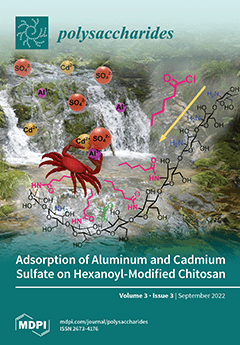Methyl cellulose and its derivatives are widely used in the food industry, cosmetics, and as construction materials. The properties of methyl celluloses (MC) strongly depend on their degrees and positions of substitution. In order to generate MCs with uncommon blocky substitution, we apply
[...] Read more.
Methyl cellulose and its derivatives are widely used in the food industry, cosmetics, and as construction materials. The properties of methyl celluloses (MC) strongly depend on their degrees and positions of substitution. In order to generate MCs with uncommon blocky substitution, we apply fully protected
O-benzyl-
O-methyl celluloses (BnMC). Such complex polysaccharide derivatives could not be deprotected completely and without shift of the composition by methods usually applied to mono- and oligosaccharides. Therefore, a facile debenzylation method was developed based on photo-initiated free-radical bromination in the presence of hydrobromic acid scavengers followed by alkaline treatment. The reaction proceeds under homogeneous conditions and without the aid of any catalyst. There is no need for expensive equipment, materials, anhydrous reagents, or running the reaction under anhydrous conditions. Reaction parameters were investigated and optimized for successful debenzylation of completely protected BnMC with degrees of methyl substitution (DS
Me) around 1.9 (and DS
Bn around 1.1). Side-product-free and almost complete debenzylation was achieved when 1,2-epoxybutane (0.5 eq./eq.
N-bromosuccinimide) and 2,6-di-
tert-butylpyridine (0.5 eq./eq.
N-bromosuccinimide) were used in the reaction. Furthermore, ATR-IR and
1H NMR spectroscopy confirmed the successful removal of benzyl ether groups. The method was developed to monitor the transglycosylation reaction of the BnMC with permethylated cellulose, for which the deprotection of many small samples in parallel is required. This comprises the determination of the methyl pattern in the glucosyl units by gas-liquid chromatography (GLC), as well as oligosaccharide analysis by liquid chromatography mass spectrometry (LC-MS) after perdeuteromethylation and partial hydrolysis to determine the methyl pattern in the chains. The unavoidable partial chain degradation during debenzylation does not interfere with this analytical application, but, most importantly, the DS and the methyl pattern were almost congruent for the debenzylated product and the original MC, indicating the full success of this approach The presented method provides an unprecedented opportunity for high throughput and parallel debenzylation of complicated glucans, such as BnMC (as a model compound), for analytical purposes. For comparison, debenzylation using Na/NH
3 was applied to BnMC and resulted in a completely debenzylated product with a remarkably high recovery yield of 99 mol% and is, thus, the method of choice for synthetic applications, e.g., for the transglycosylation product prepared under the selected conditions in a preparative scale.
Full article





